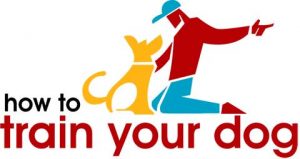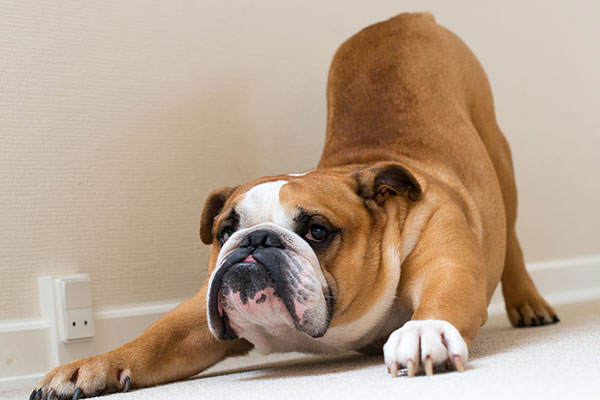If you’ve owned a dog long enough, you’ve probably seen him stretching a million times. Indeed, stretching is part and parcel of canine behavior and for the most part, it shouldn’t be a cause for concern. If anything, dogs generally look cute and adorable while they stretch.
Although there are slight variances in how dogs stretch, most dogs tend to assume a posture that looks like a ‘play bow’ or ‘prayer stance’ for yoga enthusiasts. It’s also generally observed that most dogs stretch when they’re tired or right after waking up.
But while stretching a few times a day is perfectly normal for dogs, there could be certain underlying triggers causing your canine friend to stretch a lot more than he should. If the behavior seems abnormally frequent and intense, you might find yourself wondering, why does my dog keep stretching?
Now, there are a number of reasons why dogs stretch. Most dogs stretch while they’re tired or when they need exercise. A dog can also stretch if he’s ill or injured, especially if the illness or injury affects his abdomen. Fleas and allergies could also cause your pooch to stretch a lot more than he should.
Regardless of the cause, it’s important to move with speed and resolve the situation before matters get out of hand. Without early intervention, stretching could result in a number of physical and behavioral complications, such as joint pain and obsessive-compulsive behavior.
This article examines all the possible reasons why your dog stretches and what you can do to help him out of this potentially harmful behavior.
Possible Reasons Why Dogs Stretch
If you’ve recently noticed that your dog stretches more frequently, it’s only natural to find yourself wondering, is it normal for dogs to stretch a lot?
As we’ve already pointed out, stretching is a normal part of doggy behavior.
But when stretching happens more frequently and more intensely than it should, then it could be indicative of an underlying issue.
The following are some of the reasons why your dog might be stretching a lot.
1. Instinctive Behavior
As a dog owner, you may have always wondered, ‘what are the reasons behind a dog stretching after waking up?’
One of the most likely reasons your dog keeps stretching back legs is because the animal is responding to some instinctive behavior. That’s especially if the stretching happens right after waking up.
Basically, a dog stretching immediately after taking a nap is a way of prepping his body for whatever he plans to do next. In this case, the dog responds instinctively to stretching, just as we humans normally do right after waking up from sleep.
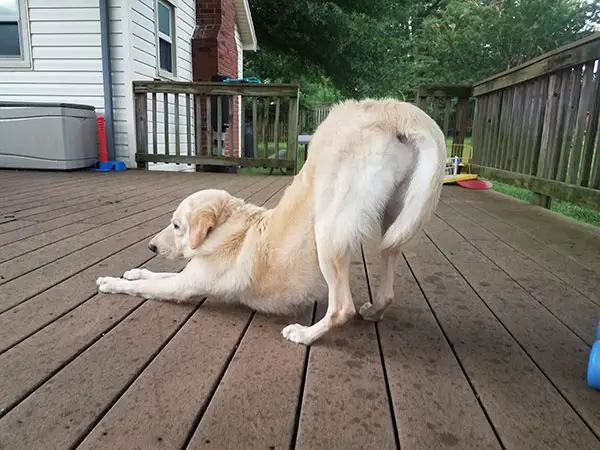
But for dogs, stretching doesn’t just happen instinctively after napping.
It’s worth noting that before domestication, dogs had to hunt down their prey and fight formidable predators as well. To succeed in these endeavors, the animals had to be in tip-top shape. And stretching was one way they warmed up their muscles in preparedness for the dangers of the wild.
Stretching enhances blood flow through the body while also helping to calm their mind; a combination that’s necessary for winning any fight.
2. Playful Behavior
Another reason dogs stretch is that they want to play, just as professional athletes do before going into a match. As we’ve just highlighted, stretching preps a dog for major activity.
Your canine friend understands that playing requires some strength and agility. And the best way to achieve that strength is by stretching his muscles.
However, it’s always important to watch out for other signs that indicate a dog is demonstrating playful behavior. For example, if the dog keeps stretching neck and looking up, that could be his way of inviting you to join in on the play.
- RICH FEEDING GAME – Look at the Big Orange Flower in the middle of the snuffle mat dog puzzle toys. Total 4 layers of orange petals can hide large…
- EXTRA FUN ATTRACTS YOUR PUPPY – We are extremely positive of our snuffle mat. But in order to provide more fun for lovely puppies, we set up 4…
- EXCELLENT RELEASE BUCKLE DESIGN – Have you ever bought a snuffle mat for your dog that want to develop good habits in your dog. But your dog likes…
Last update on 2025-01-13 / Affiliate links / Images from Amazon Product Advertising API
3. Mating Behavior
Stretching could also be part of a mating ritual. It makes the dog loosen up in readiness for the mating exercise.
This is more common with male dogs, particularly those that have not been spayed or neutered.
So, if you realize that your pooch mostly stretches whenever he spots female dogs, he could be trying to express sexual interest.
4. A Way of Relaxing the Muscles
A dog might stretch to relax his muscles. This mostly happens after a fairly long period of inactivity. So, it’s natural to expect your dog to stretch after napping or resting for several hours.
On the same note, it’s important to highlight that stretching might also correlate with the amount of physical activity your dog gets. Dogs that don’t receive enough physical stimulation tend to stretch a lot than those that do. For such dogs, stretching helps to relieve the muscle pain caused by long periods of inactivity.
Also, a dog stretching while sleeping could mean that the animal is relaxed and comfortable with his surroundings.
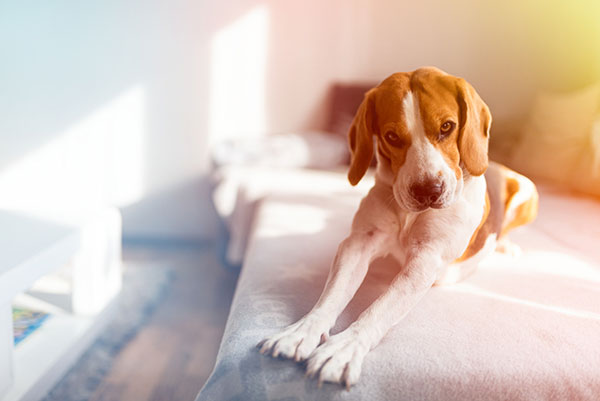
5. A Way of Greeting
If you own a dog that stretches a lot, it’s not unusual to find yourself wondering from time to time, ‘why is my dog stretching more than usual whenever we visit the dog park?’
A possible reason is that your dog is merely performing a common greeting stretch. When a dog is pleased to meet other dogs, they might demonstrate their excitement by stretching.
But dogs don’t just stretch as a way of greeting fellow dogs. They could also stretch while greeting humans, especially their owners.
So, if you’ve just come back after being gone the entire day, don’t be surprised if you spot your dog stretching in a prayer position. The animal is simply glad that you’re back to him safe and sound.
Most importantly, it helps to know other friendly gestures that show your dog is stretching as an expression of his acknowledgement of your presence. They include tail wagging, squinty eyes, and relaxed ears.
6. A Way of Cooling Off
Some dogs stretch by lying completely flat on the ground, with their bellies on the floor. This type of stretching is known as splooting and is more common with longer-legged breeds, such as Labradors and greyhounds.
Splooting helps dogs to cool themselves during warm weather.
By enlarging their surface area, dogs allow cooler air to circulate through their bodies, providing them with the warmth they need to combat the scorching summer heat.

7. Aggressive Behavior
Sometimes, stretching can be a warning behavior. In such cases, it’s imperative to heed the warning and respond appropriately.
For instance, a dog may stretch in readiness for a fight. They do that to either warn potential intruders to back off or prepare their muscles for an all-out assault.
This kind of stretching is usually accompanied by various warning signs, including baring of teeth and putting up of the hackles. The dog may also yawn, bark, growl, or make direct eye contact with the object of his aggression.
Unlike humans who mostly yawn when they’re sleepy, dogs yawn as a sign of aggression. Therefore, it’s advisable to back off and avoid all possible confrontation if you notice your dog stretching and yawning a lot.
8. Underlying Medical Condition
In some cases, stretching may be indicative of an underlying medical condition. The conditions could range from milder ones like flatulence to more severe diseases like pancreatitis and even cardiac issues.
The following are some of the common medical issues that could cause your dog to stretch a lot;
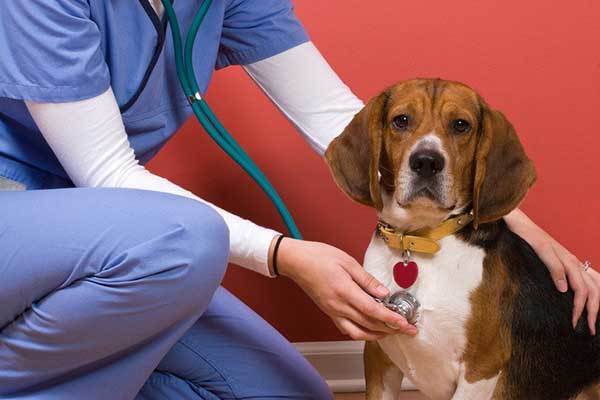
i. Digestive problems
Digestive issues that result in abdominal discomfort can make a dog stretch a lot. Stretching helps to ease the pain momentarily.
Bloat is a common digestive problem that could make your dog stretch. Also known as gastric torsion, bloat occurs when a dog’s stomach expands and twists around itself. The condition usually results from eating or drinking too soon after a period of heightened physical activity, and it’s more prominent in larger breeds like Great Danes and Bernese Mountain Dogs.
Besides stretching, bloating could also manifest in other signs, such as nausea, vomiting, excessive drooling, elevated breathing, restlessness, and a distended abdomen. So, if you find your dog throwing up and stretching a lot, bloat could be a possible trigger.
Gassiness/flatulence, acidity, inflammatory bowel disease (IBD), and gastroduodenal ulcers are other common digestive issues that could trigger stretching in dogs. By stretching, the dog attempts to relieve the gas build up in their stomach that’s making them uncomfortable.
ii. Pancreatitis
Pancreatitis refers to the inflammation of the pancreas. It’s one of the most life-threatening medical conditions in dogs. Dogs with pancreatitis tend to stretch a lot.
Pancreatitis may cause a dog to stretch by assuming a ‘praying pose,’ with their end up in the air, while their head and front legs lowered onto the floor. It’s the clearest indication ever that your canine friend is in grueling pain.
Besides stretching, dogs with pancreatitis might also lose their appetite, vomit, and diarrhea (which is soon followed by dehydration). Not to mention, the disease causes excruciating abdominal pain.

As a caring dog owner, you may occasionally find your pooch stretching and ask, what does it mean when my dog keeps stretching and not eating?
If you ever find your dog stretching a lot and not eating, pancreatitis is usually one of the reasons.
Other common symptoms of pancreatitis include lethargy, fever, and reduced mobility.
Another thing to note about pancreatitis is that the pain and diarrhea tend to worsen after eating. And that may get you wondering, my dog has diarrhea and keeps stretching immediately after eating, what could be the problem?
Again, pancreatitis could be a likely reason your dog keeps stretching after eating.
- ACTIONABLE HEALTH INSIGHTS: Test for over 270 genetic health conditions and get actionable insights to help you give your pup the best care possible….
- MOST ACCURATE BREED IDENTIFICATION: Test for over 350 dog breeds including dingoes, coyotes, wolves, and village dogs. Using a research-grade…
- TRAIT INSIGHTS THAT HELP YOU BE MORE PREPARED: Test for 55 physical traits. Size, coat, grooming needs — your dog’s traits don’t just make them…
Last update on 2025-01-13 / Affiliate links / Images from Amazon Product Advertising API
iii. Breathing Issues
Stretching helps a dog to bring more air into his chest. However, it could also indicate breathing or respiratory problems, such as bronchitis, pneumonia, pleural effusion, or congestive heart failure.
So, if you find your dog stretching back legs a lot, the animal could be having breathing issues.
Other signs of breathing problems to watch out for include excessive mucus and wet coughs. Wheezing and sneezing might also occur, especially if the problem is due to an allergic reaction.
Do dogs stretch when they are in pain?
In addition to the above medical conditions, stretching could also indicate a joint disease, such as arthritis and tendonitis. It could also suggest an underlying spinal disease or injury.
In fact, any form of pain will likely cause your dog to stretch. That’s regardless of where the pain is concentrated around his abdomen or not. Or whether the pain is a result of disease or injury.
For instance, if your dog keeps stretching and licking front legs, it’s important to have his front limbs checked for disease or injury.
- Works as a dog food topper – For pet parents looking for an alternative to capsules, raw treats, or soft chews, all it takes is a few pumps of Salmon…
- A tasty & body nourishing treat for cats & dogs – Essential fatty acids for a healthy coat.
- Powerful Omega Fatty Acids – This premium fish oil liquid formula is loaded with the healthy Omega-3 fatty acid (with epa and dha) to support health…
Last update on 2025-01-15 / Affiliate links / Images from Amazon Product Advertising API
When Is Stretching A Concern And What Can You Do About It?
Many dog owners often wonder, ‘my dog stretches a lot, should I be worried?’
As we’ve repeatedly highlighted throughout this post, stretching in dogs is not always an immediate cause for concern. In fact, the behavior should be encouraged as it offers a range of physical and mental benefits to dogs.
For starters, stretching can alleviate back pain as well as the pain associated with various chronic diseases like arthritis and tendinitis.
Stretching also stimulates the release of ‘feel-good’ hormones, such as endorphins. So, dogs that stretch more often are likely to feel happier and more relaxed than those that don’t.
Another benefit of stretching is that it’s a sign of respect. When your dog bows at you, it shows the animal ranks you higher in the family pecking order.
Last but not least, stretching encourages physical activity, socialization, and mating.
But despite its numerous benefits, stretching could also prove potentially harmful to your dog. As a dog owner, it’s important to know when the situation calls for urgent intervention.
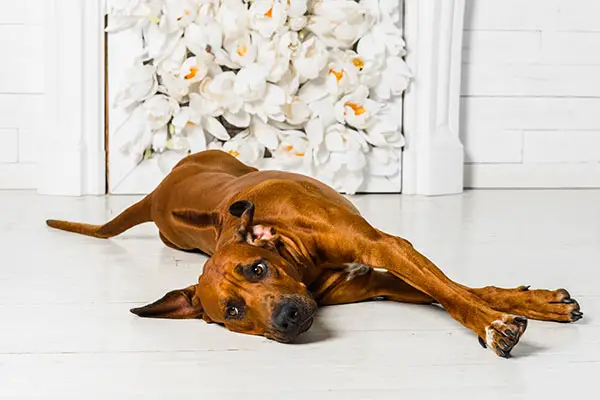
Generally, you should start by asking yourself when the dog started stretching a lot, as well as when the problem mostly occurs.
If your dog stretches only whenever you come back home, that could indicate that the animal is excited to see you. And if he only stretches when in the company of other dogs or other people, it’s likely that your pooch just wants to hang out. That’s especially if the stretching is also accompanied by other friendly gestures like tail wagging.
The next thing to do is adopt the right intervention, depending on the cause. This mostly involves checking the animal’s abdomen for any signs of abnormality. A swollen or distended abdomen could be a result of bloating, gassiness, gastric acidity, or other digestive issues. You can resolve some of these issues using various home remedies.
For instance, massaging the dog’s abdomen might help to relieve gassiness. A gentle massage will cause the gas to come out through the mouth as a burb or through the other end as a fart. Hydrotherapy is another effective home remedy that may help to relieve digestive problems in dogs.
However, be careful when attempting to administer these remedies. Depending on the severity of abdominal pain, your dog could resist all attempts to massage his belly. It’s advisable to back off if your dog shows visible signs of aggression at the prospects of touching his belly.
- Hard kibble combined with tender, shredded pieces for taste and texture dogs love
- High protein formula, with real salmon as the first ingredient
- Fortified with guaranteed live probiotics for digestive and immune health
Last update on 2025-01-09 / Affiliate links / Images from Amazon Product Advertising API
If you suspect the stretching is due to inadequate physical activity, there’s no better solution than giving your dog enough exercise. Let your pooch accompany you to your daily morning runs or routine swims.
Also, offer him enough toys to keep him stimulated even during your absence. When looking for the best dog toys, insist on interactive ones like ball launchers. You might also want to consider puzzle bowls. Puzzle bowls help to slow down the pace at which your dog eats or drinks, which might help to prevent bloating.
Most importantly, remember to enlist the services of a professional vest. That’s especially if nothing works despite your best efforts. The vet will examine the dog and establish whether the stretching is natural or triggered by an underlying disease. They’ll then prescribe the right medication based on the disease the dog is suffering from.
Conclusion: So, Why Does Your Dog Stretch So Much?
Evidently, there are numerous reasons why dogs stretch. Stretching is, first and foremost, instinctive behavior. Stretching might also result from physical inactivity, a need to socialize or mate, aggression, or a means to relax the muscles.
In some cases, there could be an underlying medical trigger. If you ever find out that your dog stretches a lot more than he should, your best bet is to take him for a veterinary checkup.

Checkout Our Favorite Dog Products
1. BEST PUPPY TOY
We Like: Snuggle Behavior Toy with Heart Beat & Heat Pack – Ideal toy for new puppies.
2. BEST DOG TRAINING PROGRAM
We Like: Doggy Dan The Online Dog Trainer – Stop any dog problem and raise the perfect puppy with The Online Dog Trainer.
3. BEST DOG PUZZLE TOY
We Like: Outward Hound Interactive Puzzle Toy – Every dog loves chasing squirrels at the park. The Outward Hound Hide-a-Squirrel Puzzle Toy gives your dog the same feeling as though he was outdoors chasing live squirrels.
4. Best Bone Broth for Dogs
We Like: (Solid Gold – Human Grade Bone Broth for Dogs) – Simmered Beef Bone Broth With Turmeric Provides A Nutrient-Dense And Flavorful Addition To Your Dog’s Meal + Rich In Natural Collagen From Beef Bones.
5. Best Multivitamin for Dogs
We Like: PetHonesty 10-For-1 Multivitamin – 10 Benefits in 1 Daily Treat – These Multivitamin Snacks combine a well-rounded blend of the most essential vitamins and supplements including glucosamine, probiotics, vitamins and omegas, for dogs’ overall daily health.
